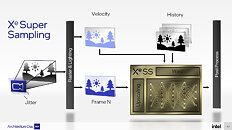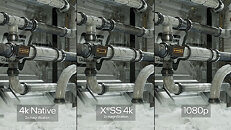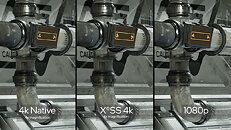- Joined
- Oct 9, 2007
- Messages
- 47,463 (7.50/day)
- Location
- Hyderabad, India
| System Name | RBMK-1000 |
|---|---|
| Processor | AMD Ryzen 7 5700G |
| Motherboard | ASUS ROG Strix B450-E Gaming |
| Cooling | DeepCool Gammax L240 V2 |
| Memory | 2x 8GB G.Skill Sniper X |
| Video Card(s) | Palit GeForce RTX 2080 SUPER GameRock |
| Storage | Western Digital Black NVMe 512GB |
| Display(s) | BenQ 1440p 60 Hz 27-inch |
| Case | Corsair Carbide 100R |
| Audio Device(s) | ASUS SupremeFX S1220A |
| Power Supply | Cooler Master MWE Gold 650W |
| Mouse | ASUS ROG Strix Impact |
| Keyboard | Gamdias Hermes E2 |
| Software | Windows 11 Pro |
Intel plans to go full tilt with gaming graphics, with its newly announced Arc line of graphics processors designed for high-performance gaming. The top Arc "Alchemist" part meets all requirements for DirectX 12 Ultimate logo, including real-time raytracing. The company, during the technology's reveal, earlier this week, also said that it's working on an AI-accelerated supersampling technology. The company is calling it XeSS (Xe SuperSampling). It likely went with Xe in the name, as it possibly plans to extend the technology to even its Xe LP-based iGPUs and the entry-level Iris Xe MAX discrete GPU.
Intel claims that XeSS cuts down 4K frame render-times by half. By all accounts, 1440p appears to be the target use case of the top Arc "Alchemist" SKU. XeSS would make 4K possible (i.e., display resolution set at 4K, rendering at a lower resolution, with AI-accelerated supersampling restoring detail). The company revealed that XeSS will use a neural network-based temporal upscaling technology that incorporates motion vectors. In the rendering pipeline, XeSS sits before most post-processing stages, similar to AMD FSR.
While AMD's FSR technology is purely shader based, the Intel algorithm can either use XMX hardware units (new in Intel Xe HPG), or DP4a instructions (available on nearly all modern AMD and NVIDIA GPUs). XMX stands for Xe Matrix Extensions and is basically Intel's version of NVIDIA's Tensor Cores, to speed up matrix math, which is used in many AI-related tasks. The Intel XeSS SDK will be available this month, in open source, using XMX hardware, the DP4a version will be available "later this year".





View at TechPowerUp Main Site | Source
Intel claims that XeSS cuts down 4K frame render-times by half. By all accounts, 1440p appears to be the target use case of the top Arc "Alchemist" SKU. XeSS would make 4K possible (i.e., display resolution set at 4K, rendering at a lower resolution, with AI-accelerated supersampling restoring detail). The company revealed that XeSS will use a neural network-based temporal upscaling technology that incorporates motion vectors. In the rendering pipeline, XeSS sits before most post-processing stages, similar to AMD FSR.
While AMD's FSR technology is purely shader based, the Intel algorithm can either use XMX hardware units (new in Intel Xe HPG), or DP4a instructions (available on nearly all modern AMD and NVIDIA GPUs). XMX stands for Xe Matrix Extensions and is basically Intel's version of NVIDIA's Tensor Cores, to speed up matrix math, which is used in many AI-related tasks. The Intel XeSS SDK will be available this month, in open source, using XMX hardware, the DP4a version will be available "later this year".





View at TechPowerUp Main Site | Source






